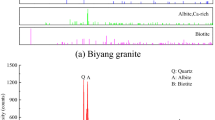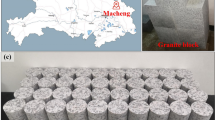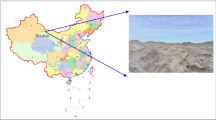Abstract
Laboratory experiments are performed on Laizhou granite samples after heating and rapid water-cooling treatment to investigate the thermal effects on the physical and mechanical properties and fracture initiation of granite during the utilization of hot dry rock. Experimental results show that P-wave velocity and tensile strength monotonously decrease because of the generation of thermally induced microcracks when the thermal treatment level increases from 25 to 500 °C. Scanning electron microscopy analysis indicates that few and isolated microcracks are observed before 300 °C, whereas microcrack networks are generated at 400 °C and 500 °C. Porosity and gas permeability sharply increase with the enhancement in the density and connectivity of microcracks. The variation trend of compressive strength tends to show a transition from increasing to decreasing at the threshold temperature. Uniaxial compressive strength and cohesion increase and the Young’s modulus slightly changes before 300 °C. Afterward, the three parameters decrease, indicating that the dominant mechanism transforms from thermal hardening to thermal cracking. Failure process of uniaxial compression shows that the proportion of crack closure region in the pre-peak stage gradually increases, whereas those of the elastic and stable crack growth regions decrease after 300 °C with the increase of the thermal treatment level. Experimental results of laboratory fracturing tests show that the decreasing tendency of breakdown pressure is similar to that of tensile strength. The pressure build-up rate substantially decreases because of the enhancement in fluid leak-off, and hydraulic fracture initiation occurs before the breakdown of granite samples when the thermal treatment levels are higher than 300 °C. Shear failure becomes dominant based on the hypocenter mechanism analysis of acoustic emission events.













Similar content being viewed by others
Abbreviations
- T :
-
Temperature
- σ t :
-
Tensile strength
- σ c :
-
Confining pressure
- σ p :
-
Compressive strength/Peak stress
- E :
-
Young’s modulus
- v :
-
Poison’s ratio
- C :
-
Cohesion
- φ :
-
Internal fraction angle
- σa, εa :
-
Axial stress and strain, respectively
- σcc, εcc :
-
Axial stress and strain thresholds indicating crack closure, respectively
- σci, εci :
-
Axial stress and strain thresholds indicating crack initiation, respectively
- σcd, εcd :
-
Axial stress and strain thresholds indicating crack damage, respectively
- ε p :
-
Peak strain
- P b :
-
Breakdown pressure
References
Breede K, Dzebisashvili K, Liu X, Falcone G (2013) A systematic review of enhanced (or engineered) geothermal systems: past, present and future. Geoth Energy 1:1–27
Brotóns V, Tomás R, Ivorra S, Alarcón JC (2013) Temperature influence on the physical and mechanical properties of a porous rock: San Julian's calcarenite. Eng Geol 167:117–127
Chen JL, Jiang FM (2015) Designing multi-well layout for enhanced geothermal system to better exploit hot dry rock geothermal energy. Renew Energy 74:37–48
Chen Y, Nagaya Y, Ishida T (2015) Observation of fracture induced by hydraulic fracturing in anisotropic granite. Rock Mech Rock Eng 48:1455–1461
Damjanac B, Fairhurst C (2010) Evidence for a long-term strength threshold in crystalline rock. Rock Mech Rock Eng 43:513–531
Diaz MB, Jung SG, Zhuang L, Kim KY, Yeom S, Shin HS. (2016) Effect of cleavage anisotropy on hydraulic fracturing behavior of Pocheon granite. In: 50th US Rock Mechanics/Geomechanics Symposium, American Rock Mechanics Association
Fairhurst CE, Hudson JA (1999) Draft ISRM suggested method for the complete stress-strain curve for the intact rock in uniaxial compression. Int J Rock Mech Min Sci Geomech Abs 36(3):281–289
Fan LF, Gao JW, Wu ZJ, Yang SQ, Ma GW (2018) An investigation of thermal effects on micro-properties of granite by X-ray CT technique. Appl Therm Eng 140:505–519
Finnie I, Copper GA, Berlie J (1979) Fracture propagation in rock by transient cooling. Int J Rock Mech Min Sci Geomech Abs 16:11–21
Fu PC, Hao Y, Walsh Stuart DC, Carrigan CR (2016) Thermal drawdown-induced flow channeling in fractured geothermal reservoirs. Rock Mech Rock Eng 49:1001–1024
Genter A, Evans K, Cuenot N, Fritsch D, Sanjuan B (2010) Contribution of the exploration of deep crystalline fractured reservoir of Soultz to the knowledge of enhanced geothermal systems (EGS). CR Geosci 342(7–8):502–516
Ghassemi A (2012) A review of come rock mechanics issues in geothermal reservoir development. Geotech Geol Eng 30:647–664
Hampton J, Frash L, Gutierrez M. (2013) Investigation of laboratory hydraulic fracture source mechanisms using acoustic emission. In: 47th US Rock Mechanics/Geomechanics Symposium, American Rock Mechanics Association
Heap MJ, Baud P, Meredith PG (2009) The influence of temperature on brittle creep in sandstones. Geophys Res Lett 36:L19305
Heap MJ, Violay M, Wadsworth FB, Vasseur J (2017) From rock to magma and back again: the evolution of temperature and deformation mechanism in conduit margin zones. Earth Planet Sci Lett 463:92–100
Hu XD, Wu K, Li GS, Tang JZ, Shen ZH (2018a) Effect of proppant addition schedule on the proppant distribution in a straight fracture for slickwater treatment. J Petrol Sci Eng 167:110–119
Hu XD, Song XZ, Li GS, Shen ZH, Lyu ZH, Shi Y (2018b) Shape factor of the flake-like particle in thermal spallation and its effects on settling and transport behavior in drilling annulus. Powder Technol 335:211–221
Hu XD, Song XZ, Li GS, Shen ZH, Lyu ZH, Shi Y, Zheng R (2018c) An analytical model to evaluate the heating conditions for drilling in hard rock using an innovative hydrothermal spallation method. Appl Therm Eng 142:709–716
Ishida T, Aoyagi K, Niwa T, Chen Y, Murata S, Chen Q, Nakayana Y (2012) Acoustic emission monitoring of hydraulic fracturing laboratory experiment with supercritical and liquid CO2. Geophys Res Lett. https://doi.org/10.1029/2012GL052788
Jansen DP, Carlson SR, Young RP, Hutchins DA (1993) Ultrasonic imaging and acoustic emission monitoring of thermally induced microcracks in Lac du Bonnet granite. J Geophys Res-Solid Earth 98(B12):22231–22243
Jin PH, Hu YQ, Shao JX, Zhao GK, Zhu XZ, Li C (2018) Experimental study on physico-mechanical and transport properties of granite subjected to rapid cooling. Chin J Rock Mech Eng 37(11):2556–2564
Kamali-Asl A, Ghazanfari E, Perdrial N, Bredice N (2018) Experimental study of fracture response in granite specimens subjected to hydrothermal conditions relevant for enhanced geothermal systems. Geothermics 72:205–224
Kim K, Kemeny J, Nickerson M (2014) Effect of rapid thermal cooling on mechanical rock properties. Rock Mech Rock Eng 47(6):2005–2019
Kim KH, Ree JH, Kim YH, Kim S, Kang SY, Seo W (2018) Assessing whether the 2017 Mw 5.4 Pohang earthquake in South Korea was an induced event. Sci Rep 360:1007–1009
Kong B, Wang EY, Li ZH, Wong XR, Liu XF, Li N, Yang YL (2016) Electromagnetic radiation characteristics and mechanical properties of deformed and fractured sandstone after high temperature treatment. Eng Geol 209:82–92
Kumari WGP, Ranjith PG, Perera MSA, Chen BK, Abdulagatov IM (2017) Temperature-dependent mechanical behavior of Australian Strathbogie granite with different cooling treatments. Eng Geol 229:31–44
Kumari WGP, Ranjith PG, Perera MSA, Li X, Li LH, Chen BK, Avanthi Isaka BL, De Silva VRS (2018) Hydraulic fracturing under high temperature and pressure conditions with micro CT applications: geothermal energy from hot dry rocks. Fuel 230:138–154
Li N, Zhang SC, Ma XF, Zou YS, Chen M, Li SH, Zhang YN (2017) Experimental study on the propagation mechanism of hydraulic fracture in glutenite formations. Chin J Rock Mech Eng 36(10):2383–2392
Li N, Zhang SC, Ma XF, Zou YS, Wu S, Zhou JW, Sun YY, Zhou T. (2018a) Experimental investigation into dynamics of laboratory hydraulic fracturing based on acoustic emission monitoring. In: 52nd US Rock Mechanics/Geomechanics Symposium, American Rock Mechanics Association
Li N, Zhang SC, Zou YS, Ma XF, Wu S, Zhang YN (2018) Experimental analysis of hydraulic fracture growth and acoustic emission response in a layered formation. Rock Mech Rock Eng 51(4):1047–1062
Li N, Zhang SC, Zou YS, Ma XF, Zhang ZP, Li SH, Chen M, Sun YY (2018) Acoustic emission response of laboratory hydraulic fracturing in layered shale. Rock Mech Rock Eng 51(11):3395–3406
Li N, Zhang SC, Ma XF, Zou YS, Cao T. (2019a) Experimental research on the effect of cold water injection on the mechanical properties and brittleness of granite in HDR. In: 53rd US Rock Mechanics/Geomechanics Symposium, American Rock Mechanics Association.
Li N, Zhang SC, Ma XF, Li SH, Zhang ZP, Zou YS. (2019b) Temperature-dependency of mechanical properties of hydraulic fracture surface and its influence on conductivity: an experimental study for development of geothermal energy. In: ARMA-CUPB Geothermal International Conference, American Rock Mechanics Association.
Li Q, Yin TB, Li XB, Zhang SS (2019) Effects of rapid cooling treatment on heated sandstone: a comparison between water and liquid nitrogen cooling. Bull Eng Geol Environ. https://doi.org/10.1007/s10064-019-01571-6
Li SH, Zhang SC, Ma XF, Zou YS, Li N, Chen M, Cao T, Bo ZK (2019) Hydraulic fractures induced by water-/carbon-dioxide-based fluids on tight sandstones. Rock Mech Rock Eng. https://doi.org/10.1007/s00603-019-01777-w
Li N, Zhang SC, Ma XF, Zou YS, Li SH, Zhang ZP (2020) Thermal effect on the evolution of hydraulic fracture conductivity: an experimental study of enhanced geothermal system. J Petrol Sci Eng 187:106814
Liu Q, Xu X (2000) Damage analysis of brittle rock at high temperature. Chin J Rock Mech Eng 19(4):408–411
Ma XF, Li N, Yin CB, Li YC, Zou YS, Wu S, He F, Wang XQ, Zhou T (2017) Hydraulic fracture propagation geometry and acoustic emission interpretation: a case study of Silurian Longmaxi formation shale in Sichuan Basin China. Petrol Explor Dev. 44(6):974–981
Martin CD (1997) Seventeenth Canadian geotechnical colloquium: the effect of cohesion loss and stress path on brittle rock strength. Can Geotech J 34:398–725
Meredith PG, Atkinson BK (1985) Fracture toughness and subcritical crack growth during high-temperature tensile deformation of Westerly granite and Black gabbro. Phys Earth Planet Inter 39(1):33–51
Mouzannar H, Bost M, Leroux M, Virely D (2017) Experimental study of the shear strength of bonded concrete–rock interfaces: surface morphology and scale effect. Rock Mech Rock Eng 50:2601–2625
Nasseri MHB, Tatone BSA, Grasselli G, Young RP (2009) Fracture toughness and fracture roughness interrelationship in thermally treated Westerly Granite. Pure appl Geophys 166:801–822
Peng J, Rong G, Cai M, Yao M, Zhou C (2016) Comparison of mechanical properties of undamaged and thermal-damaged coarse marbles under triaxial compression. Int J Rock Mech Min Sci 83:135–139
Ranjith PG, Viete DR, Chen BJ, Perera MSA (2012) Transformation plasticity and the effect of temperature on the mechanical behaviour of Hawkesbury sandstone at atmospheric pressure. Eng Geol 151:120–127
Safari R, Ghassemi A (2015) 3D thermo-poroelastic analysis of fracture network deformation and induced micro-seismicity in enhanced geothermal systems. Geothermics 58:1–14
Salimzadeh S, Paluszny A, Nick HM, Zimmerman RW (2018) A three-dimensional coupled thermo-hydro-mechanical model for deformable fractured geothermal systems. Geothermics 71:212–224
Shao SS, Ranjith PG, Wasantha PLP, Chen BK (2015) Experimental and numerical studies on the mechanical behaviour of Australian Strathbogie granite at high temperatures: an application to geothermal energy. Geothermics 54:96–108
Stanchits S, Surdi A, Edelman E, Suarez-Rivera R (2012) Acoustic emission and ultrasonic transmission monitoring of hydraulic fracture propagation in heterogeneous rock samples. In: 46th US rock mechanics/geomechanics symposium, American Rock Mechanics Association
Stanchits S, Burghardt J, Surdi A (2015) Hydraulic fracturing of heterogeneous rock monitored by acoustic emission. Rock Mech Rock Eng 48(6):2513–2527
Stephansson O, Semikova H, Zimmermann G, Zang A (2019) Laboratory pulse test of hydraulic fracturing on granitic sample cores from Äspö HRL, Sweden. Rock Mech Rock Eng 52:629–633
Tang J, Wu K, Zeng B, Huang H, Hu X, Guo X, Zuo L (2018) Investigate effects of weak bedding interfaces on fracture geometry in unconventional reservoirs. J Petrol Sci Eng 165:992–1009
Tang J, Wu K, Li Y, Hu X, Liu Q, Ehlig-Economides C (2018) Numerical investigation of the interactions between hydraulic fracture and bedding planes with non-orthogonal approach angle. Eng Fract Mech. https://doi.org/10.1016/j.engfracmech.2018.07.010
Tenma N, Yamaguchi T, Zyvoloski G (2008) The Hijiori hot dry rock test site, Japan: evaluation and optimization of heat extraction from a two-layered reservoir. Geothermics 37(1):19–52
Tester JW, Anderson BJ, Batchelor AS, Blackwell DD, DiPippo R, Drake EM, Garnish J, Livesay B, Moore MC, Nichols K (2007) Impact of enhanced geothermal systems on US energy supply in the twenty-first century. Philos Trans R Soc Lond A 365:1057–1094
Tran NH, Rahman SS (2007) Development of hot dry rocks by hydraulic stimulation: natural fracture network simulation. Theor Appl Fract Mech 47(1):77–85
Wan Z, Zhao Y, Kang J (2005) Forecast and evaluation of hot dry rock geothermal resource in China. Renew Energy 30(12):1831–1846
Wang Y, Liu BL, Zhu HY, Yan CL, Li ZJ, Wang ZQ (2014) Thermophysical and mechanical properties of granite and its effects on borehole stability in high temperature and three-dimensional stress. Sci World J 3–4:650–683
Wang QS, Chen JX, Guo JQ, Luo YB, Wang HY, Liu Q (2017) Acoustic emission characteristics and energy mechanism in karst limestone failure under uniaxial and triaxial compression. Bull Eng Geol Environ 3:1–16
Wong TF, David C, Zhu W (1997) The transition from brittle faulting tocataclastic flow in porous sandstones: mechanical deformation. J Geophys Res 102:3009–3025
Xing YK, Zhang GQ, Luo TY, Jiang YW, Ning SW (2019) Hydraulic fracturing in high-temperature granite characterized by acoustic emission. J Petrol Sci Eng 178:475–484
Xu XL, Gao F, Shen XM, Jin CH (2010) Research on mechanical characteristics and micropore structure of granite under high-temperature. Rock Soil Mech 31(6):1752–1758
Yang SQ, Ranjith PG, Huang YH, Yin PF, Jing HW, Gui YL, Yu QL (2015) Experimental investigation on mechanical damage characteristics of sandstone under triaxial cyclic loading. Geophys J Int 201:662–682
Yang SQ, Ranjith PG, Jing HW, Tian WL, Ju Y (2017) An experimental investigation on thermal damage and failure mechanical behavior of granite after exposure to different high temperature treatments. Geothermics 65:180–197
Yin TB, Shu RH, Li XB, Wong P, Liu XL (2016) Comparison of mechanical properties in high temperature and thermal treatment granite. Trans Nonferrous Met Soc China 26:1926–1937
Yoon JS, Zimmermann G, Zang A, Stephansson O (2015) Discrete element modeling of fluid injection–induced seismicity and activation of nearby fault. Can Geotech J 52(10):1457–1465
Zang A, Zimmermann G, Hofmann H, Stephansson O, Min KB (2019) How to reduce fluid-injection-induced seismicity. Rock Mech Rock Eng 52:475–493
Zeng YC, Su Z, Wu NY (2013) Numerical simulation of heat production potential from hot dry rock by water circulating through two horizontal wells at Desert Peak geothermal field. Energy 63:268–282
Zhang ZZ, Gao F, Xu XL (2011) Experimental study of temperature effect of mechanical properties of granite. Rock Soil Mech 32(8):2346–2352
Zhang LY, Mao XB, Liu RX, Guo X, Ma D (2014) The mechanical properties of mudstone at high temperatures: an experimental study. Rock Mech Rock Eng 47:1479–1484
Zhang F, Zhao JJ, Hu DW, Skoczylas F, Shao JF (2017) Laboratory investigation on physical and mechanical properties of granite after heating and water-cooling treatment. Rock Mech Rock Eng 51(3):677–694
Zhao YS, Feng ZJ, Xi BP, Wan ZJ, Yang D, Liang WG (2015) Deformation and instability failure of borehole at high temperature and high pressure in hot dry rock exploitation. Renew Energy 77(1):159–165
Zhu HH, Yan ZG, Deng T, Yao J, Zeng LJ, Qiang J (2006) Testing study of mechanical properties of tuff, granite and breccia after high temperatures. Chin J Rock Mech Eng 25(10):1945–1950
Zhu TT, Jing HW, Su HJ, Yin Q, Du MR, Han GS (2016) Physical and mechanical properties of sandstone containing a single fissure after exposure to high temperatures. Int J Min Sci Technol 26:319–325
Zhu HY, Tao L, Liu QY, Lei ZD, Jiang S, Mclennan JD (2018) Fracture characteristics and change of permeability under the influence of natural fractures: experimental study of Wufeng-Longmaxi shale. SPE Reserv Eval Eng 21(02):225–237
Zhuang L, Kim KY, Jung SG, Diaz M, Min KB (2018) Effect of water infiltration, injection rate and anisotropy on hydraulic fracturing behavior of granite. Rock Mech Rock Eng 52(2):575–589
Zou YS, Ma XF, Zhou T, Li N, Chen M, Li SH, Zhang YN, Li H (2017) Hydraulic fracture growth in a layered formation based on fracturing experiments and discrete element modeling. Rock Mech Rock Eng 50:2359
Zou YS, Li N, Ma XF, Zhang SC, Li SH (2018) Experimental study on the growth behavior of supercritical CO2-induced fractures in a layered tight sandstone formation. J Nat Gas Sci Eng 49:145–156
Zuo JP, Zhou HW, Fang Y, Meng BB, Peng RD (2011) Experimental research on thermal cracking of deep granite in Beishan Region, Gansu Province. Chin J Rock Mech Eng 30(6):1107–1115
Acknowledgements
This paper was supported by the National Natural Science Foundation of China (Nos. 51574255; 51704305), the Major National Science and Technology Projects of China (Nos. 2016ZX05046-004; 2017ZX05039002-003) and the National Basic Research Program of China (No. 2015CB250903).
Author information
Authors and Affiliations
Corresponding author
Ethics declarations
Conflict of interest
The authors declare no competing financial interest.
Additional information
Publisher's Note
Springer Nature remains neutral with regard to jurisdictional claims in published maps and institutional affiliations.
Rights and permissions
About this article
Cite this article
Li, N., Ma, X., Zhang, S. et al. Thermal Effects on the Physical and Mechanical Properties and Fracture Initiation of Laizhou Granite During Hydraulic Fracturing. Rock Mech Rock Eng 53, 2539–2556 (2020). https://doi.org/10.1007/s00603-020-02082-7
Received:
Accepted:
Published:
Issue Date:
DOI: https://doi.org/10.1007/s00603-020-02082-7




